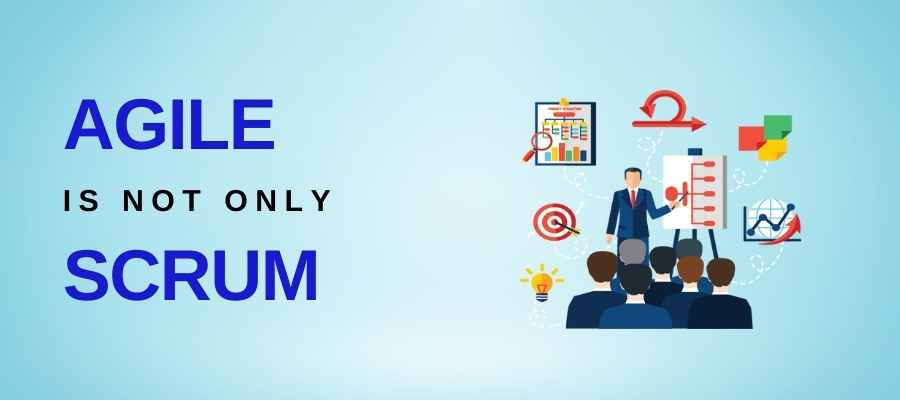Agile Is Not Only Scrum

Are you confusing the “Agile” methodology with “Scrum”? Today, when most organizations are adapting to Agile Transformation, it’s understandable that you might not know many terminologies and processes. But, it’s important to take relevant Agile Training to understand how “Agile is not only Scrum.” After all, your responsibility as the Scrum Master, Product Owner, or Project Manager is to utilize the suitable methodology for the ultimate Digital Transformation. Here we will discuss different facts related to the argument that “Agile is not only Scrum.”
What Is The Agile Framework?
An Agile Framework is an iterative approach to project completion. This approach carters measurable ROI through its pre-defined and iterative product delivery features. Agile practices require continuous client involvement to align the project expectations from the project manager towards the Agile Developers and Scrum Team. For that, the Certified Scrum Product Owner makes adaptive changes through different Agile processes. Now let’s discover different Agile Methodologies.
Get Familiarized With Popular Agile Methodologies:
The primary values and principles of an Agile approach must be applied across different process methodologies. Some of them are:
1. Kanban:
This Agile methodology promotes a workflow visualization tool called “Kanban Board” to improve the entire project management process. The Developers use the Kanban Board to create and manage their representing project development tasks. As the project progresses, the designed task cards change their status from “in progress” to “complete.” This centralized dashboard allows the Scrum Team to work collaboratively with the development and testing teams. Also, the Certified Scrum Master utilizes the dashboard to keep track of the project’s overall progress.
2. Extreme Programming (XP):
Extreme Programming (XP) is a unique Agile software development framework. XP allows Agile Developers to build higher quality software with a great product delivery life cycle. This method is best suited for the following scenarios:
- Dynamically changing product feature requirements.
- Risks invoked by fixed-time project planning and Sprint Planning.
- Early Release of a product/software developed with new technology.
- The co-location of the development team, Scrum Team, and testing team.
- Bring technology automation with functional tests.
Well, the CSPO cannot use the XP method alone. He has to combine it with different Agile methodologies, such as Kanban, Scrum, etc., to meet the Product Goal as per his unique Product Vision.
3. Scrum:
Scrum is currently the most popular Agile methodology project managers use to bring the ultimate Digital Transformation. Agile being a philosophy, Scrum is its methodology that helps the Scrum Master to manage several project activities and meet the Product Goal.
Scrum is a process that answers all the below queries of the Certified Scrum Product Owner:
- How to identify the workload?
- Who will do the job?
- How to complete the job?
- When can the work be completed?
With the Scrum process, the project delivery team, consisting of the project manager, Product Owner, Scrum Team, Developers, and other cross-functional teams, aims to meet the Product Goal at the right time. The Scrum methodology also helps the project manager in Sprint Planning and defining smaller project scopes for Sprint Retrospective. At the sprint end, the product Release happens to complete the delivery to the end users.
Finally, it’s safe to say,
Scrum is a process that follows the Agile approach.
Differentiating Agile From Scrum:
On the surface, it’s clear that Scrum is an Agile approach that is effectively used for smooth project and product delivery management. However, Agile and Scrum rely on the same iterative process, making people even more confused. So let’s list down the main differences here:
1. Agile is a philosophy that utilizes key values or principles - Scrum is a type of Agile methodology that involves different processes related to project delivery.
2. Scrum processes can be broken down into sprints through Sprint Planning - Agile has a single delivery goal to meet at the end of the project.
3. Agile involves professionals such as Project Managers, Product Owners, and various cross-functional teams - Scrum includes a Scrum Master, Scrum Team, and Product Owner.
4. With Agile, the Product Goal is reviewed on a regular basis - Scrum focuses on the Sprint Goal, finishing one activity after another as per the Product Roadmap.
Remember, Scrum will always be an Agile approach. However, Agile is not only Scrum - Agile has different methodologies that help organizations to meet their Digital Transformation goals.
Summing Up: Selecting The Right Agile Approach
Hopefully, you are now clear about the different Agile methods, including Scrum. These methods have the following things in common:
- They are easily adaptable to changes
- They have a defined Product Goal to finish
- They propagate smooth inter-team communication and interaction
All Agile approaches are adaptive, integrable, and valuable. However, which method is suitable for the project completely depends upon the Product Owner’s unique Product Vision and end-user requirements. So, decide the project priorities to include Scrum or any other Agile approach.
Reference
- https://theagiletimes.com/agile-is-not-scrum/
- https://reqtest.com/agile-blog/is-agile-just-scrum/



